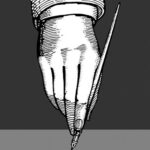“Reyes did not succumb to intimidation. In his twenties, he wrote reviews admirable for their prose, liveliness, and precision as a philologist in full command of his technique, with the double meaning of being professional and of writing at a level far above that of his profession: as a true writer.”
Among the tales and legends of industrial folklore, there is a story of a man who pushed along materials in a wheelbarrow, suspiciously. Time and again, the inspectors checked his documentation and found that everything was in order; they checked the materials, to see if he was hiding something else, and it came to naught. The man went on his way smiling, as if having pulled off some mischief, and the inspectors were left befuddled, beaten at a game they did not understand. It took them quite some time to discover he was stealing the wheelbarrows.
The inspectors of Alfonso Reyes may seem luckier, but this is not the case. Time and again, they have discovered his knowledge of Greek was limited and his academic credentials (a simple undergraduate degree in law) were entirely insufficient for the matters he addressed; in many cases, he made use of second-hand sources; worse still, on one occasion or another, he did nothing but put others’ materials in his own words. Put bluntly: his essays were pure dissemination. What was his speciality? In what area had he authority? He wrote well, but about everything. He drifted in and out of academic fields with no respect for jurisdictions. He sacked the library, as if everything were his. This cannot be. He pushed the wheelbarrow gracefully, but there was nothing in it.
Here, as in his poetry, there is a problem with the reader’s expectations. If every poem should be intense and fascinating, Reyes’s disappoint. If prose is no more than the vehicle by which the results of academic research are displayed, his essays have little to contribute. But the short-sighted reader who sees him in these terms only gets what he deserves; he misses out on the best prose in the world: a surprising result that this brilliant researcher hid in transparency; an unexpected vehicle he stole from the gods, worth infinitely more than the facts it transports. Fact that are generally obsolete the next day, and nonetheless perennial in the smile of an indulgent stroll.
The artistic research of language is research. From it can emerge discoveries important to those able to appreciate them, and even to the uninitiated. But these disseminations, discoveries, and research are invisible to the inspectors.
Millenia ago, a poet discovered that one can exchange the words used for running water and tears. What was new to this experiment? The fact that never before had a phrase like “rivers of tears” been put together; a phrase that can be put together, and that says something never-before-said about pain: it can feel like something wide and fast-flowing. Some pains burn like acid; some pains weigh on you like stones; some pains shake, some suffocate, some poison. But there are also pains that spring up fast-flowing and run like a river. Here was a three-part discovery: linguistic (the construction is valid, although it had never before been attempted), literary (a new metaphor, lovely and expressive), and psychological (the taxonomy of pain is enriched with a further category).
Dissemination, naturally, was not a matter of explaining the discovery to laypeople. It was simply a matter of making use of said discovery until this phrase became a part of popular speech. Or of constructing variants based on this find, some so far from the original that they became additional discoveries. For example: that of the poet who paddled all the way back to the origin of tears, turning the metaphor around, and said fountainheads were eyes. This new metaphor was so thoroughly disseminated that it entered the lexicon: in Spanish, calling a fountainhead an “ojo de agua” is no longer considered a poetic creation on the author’s part, but rather the name of something, like all other names in our vocabulary.
An essay is not a research report on experiments carried out in the laboratory: it is the laboratory itself, where life is “assayed” in a text, where the author’s imagination, creativity, experimentation, and critical sense are unfurled. That is what it means to compose an essay: to test and investigate new formulations habitable by reading, new possibilities to be reading.
The misunderstanding arises when the essay—instead of referring, for example, to “La melancolía del viajero” (Calendario), the traveler’s melancholy—refers to matters that could or should (according to the narrow-minded reader) be deemed academic (“Fortuna española de un verso italiano,” Entre libros). It arises when the reader reads only the surmountable facts, not the insurmountable prose. Thus, likewise, the inspector might be outraged by an actor who does a marvelous job of playing the bad guy, instead of admiring him. Or be outraged by Shakespeare, because in writing the play he made use of someone else’s plot. Or by the painter who considers himself the owner of the copy he made of a painting he liked at the museum, for the purpose of its observation and recreation through his recreation (just as Reyes rewrote in turn and published, in his Archivo, a book he liked). Or be outraged by the audience that listens to the St. Matthew Passion but does not know German, when what matters about this work is not what the words say, but what Bach says.
Reyes understood the problem, and he helps us understand it with a memorable metaphor: the essay is the centaur of the genres. A centaur inspector would have a hard time understanding the game if he thought a centaur was a man on a horse—if he thought the horse was merely a means of transport. The essay is art and science, but its science lies not in the content it carries, but rather in the wheelbarrow itself; it is not the science of the professor (although he may make use of it, it may light his way and lead him down new paths): its science is that of the artist capable of experimenting, combining, searching, imagining, building, criticizing what he means to say before knowing what it is. The knowledge that matters in an essay is the knowledge that is unknown, that is sought out, that is finally realized when it is written: the knowledge that did not exist before, even when the author knew many other bits of knowledge before, whether his own or of others, which helped him to compose the essay.
“The reader incapable of recreating himself, of reconstituting himself, of reorganizing himself through reading an essay that truly assays is a reader impoverished by technocratic culture. He does not know they have stolen his wheelbarrow.”
The essayist can advance down both paths because the centaur demands it. He can discover not only important, novel texts that emerge from his self, his mind, his hands, but also things that specialists had never discovered, and of which they ought make use. Unfortunately, they cannot make use of them without putting their reputation at risk. It is assumed that, outside of the guild, there can be no valid discoveries. This is why the lowdown grift of making use without recognition is so common: to cite an essayist in a “scientific” work is frowned upon. This is a trivial matter, of no literary importance, unless essayists succumb to intimidation and behave as if creative writing were less important, or less valid as research, than academic work.
Reyes did not succumb to intimidation. In his twenties, he wrote reviews admirable for their prose, liveliness, and precision in the Revista de Filología Española (collected in Entre libros) as a philologist in full command of his technique, with the double meaning of being professional and of writing at a level far above that of his profession: as a true writer. He recalled as much at the Tecnológico de Monterrey, thirty years later (“Mi idea de la historia,” Marginalia, second series): “For many a long year, I gave myself over to the disciplines of the document, from that of seeking it out to that of publishing it along with all its critical apparatus. But nonetheless, I would not mistake these initiatory disciplines for the exegesis and assessment of culture to which I aspired. The fact is that scholarly guile is reducible to rules, automatic and easily taught, and that, once learned, are applied with impersonal monotony. This is not the case for the arts of interpretation and narration, whose technique depends on having talent.”
The importance of this distinction and, above all, this hierarchy, stands out in the reviews of Entre libros, which are still easy to savor though they were written between 1912 and 1923. No matter that the books and insights to which they refer are dated. What is truly novel, and is still new to this day, as Pound would say (“Poetry is news that says news”), lies in their prose fashioned as poetry. The facts age, the wheelbarrow does not.
It is possible and desirable, as Reyes’s case shows, that a specialist should be much more than a specialist: an assaying spirit, a true writer. This has been the case for philosophers, historians, jurists, physicians. But the university, as a center for the education of technocrats, scorns general knowledge (as opposed to wage-earning knowledge) and the author’s knowledge (as opposed to the knowledge authorized by official procedures and credentialism). The creation of ideas, metaphors, perspectives, and ways of seeing things is as naught in opposition to the “solidity” of academic work. The proper hierarchy is the opposite.
The essay is so difficult that mediocre writers should not compose essays: they should limit themselves to academic work. It is only natural that specialists—especially when science demands high budgets—should be aware of the importance of public relations; that they should undertake social communication along two lines: formally sharing their work with their colleagues in peer-reviewed journals, and dissemination for the general public; that they should see essays as dissemination. That they should even hire writers to present their research. But the essay is a literary genre of intellectual creativity, not a service to dissemination.
The ancillary function (as Reyes called it in El deslinde) uses prose as an ancilla—a servant, a slave, a maid for the material carried; as the wheelbarrow subordinate to the specialist’s laboratory. The essay, on the other hand, subordinates the facts (be they specialized or not) to the laboratory of prose, the laboratory of the knowledge sought in hitherto unseen formulations, the laboratory of the being that questions itself, critiques itself, and recreates itself in a text.
The reader incapable of recreating himself, of reconstituting himself, of reorganizing himself through reading an essay that truly assays is a reader impoverished by technocratic culture. He does not know they have stolen his wheelbarrow.
Translated by Arthur Malcolm Dixon
Gabriel Zaid, “La carretilla Alfonsina,” in Leer poesía, in Obras de Gabriel Zaid Vol. 3, 3rd ed.
(Mexico: El Colegio Nacional, 2020), 115-119.
Published with the author’s permission.



